Pedal Power Fiasco
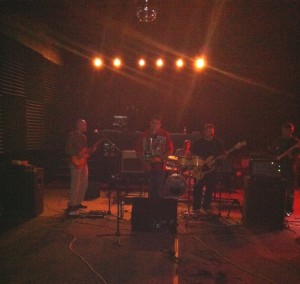
After a bit of trial and error, it was clear that my ancient SKB PS-25 pedalboard power supply had finally keeled over. I never use batteries, but fortunately a couple of the pedals had old 9V batteries still in them, so it was enough to scrape by for the rehearsal.

Hey, here’s the power supply for my Digitech Jamman Delay which I’m not currently using in my live rig. It says 9V, 1.3A. Strange, it doesn’t show a polarity, but it’s a power supply for a guitar pedal, and the plug barrel fits, so it must be good, right? What could possibly go wrong?

It was with a sense of dread that I unplugged the power cables, and tried the pedals on battery. No lights, no sound- nothing. They were all fried.
So, there I was, with just hours before the gig was to start, with a miserable collection of dead pedals. Fortunately, our bass player Ryan, had a Tube Screamer, Fulltone Full Drive 2, and Fulltone Fat-Boost in his old guitar gear bag. I loaded em up with batteries and velcroed em down. It all sounded different, and felt unfamiliar under my feet, but I made it through the gig ok.
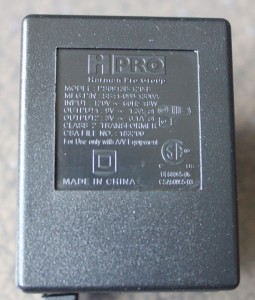
But honestly, shame on Digitech for selling a pedal with a power supply that says 9V, has a standard pedal barrel connector, but is actually AC, not DC. They should at least make the connector different so it won’t fit a standard pedal jack!
In the week following the gig, I took apart and fixed my pedals- blown diodes in my Speed Racer overdrive were about the worst of it. No big deal.
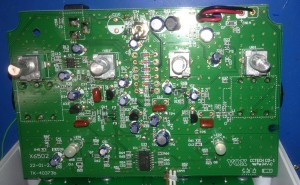
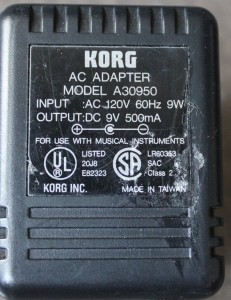
Update 5/22/2013: I figured out why the boost was humming- I hooked up a multimeter to that Korg power supply, and turns out that it’s really putting out 13V, not 9V. What is up with these power supply labels?!
Our next Drop Daddies gig is tomorrow night, and we’re heading back to the Annex for a rehearsal tonight. Note to self, pack some 9V batteries, just in case
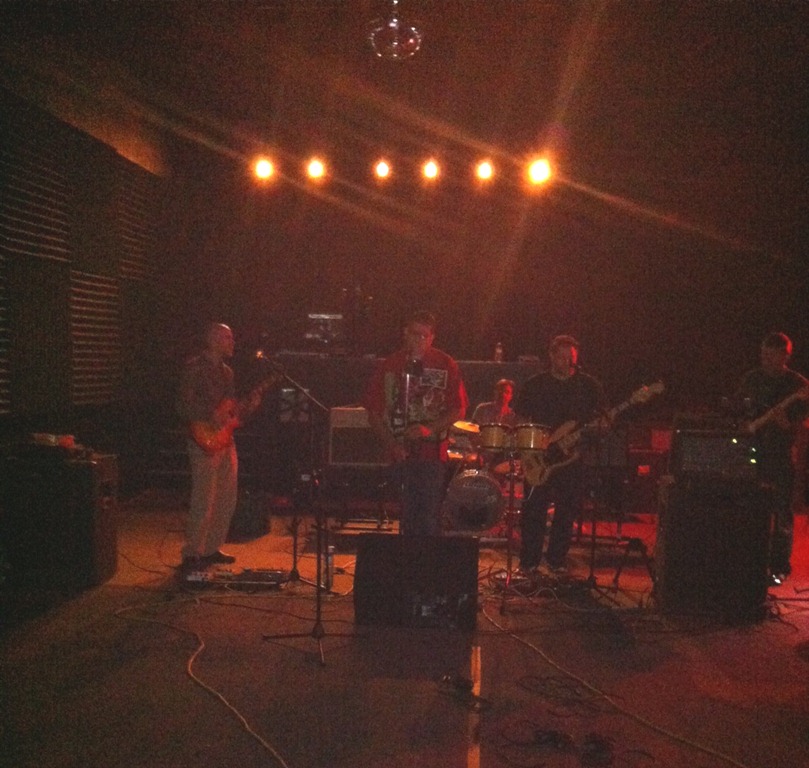
April 26, 2013 @ 3:57 am
Wow, that sucks. I did the same once but my pedals somehow survived without damage.
Do you have Thomann in California? I bought the cheap Chinese Harley Benton Power suplies from them (standard & junior) and they both work great. The big one eben has an AC & an 18VDC Jack. One is about 40 Euro, the other 30.
April 26, 2013 @ 11:02 am
No, we don’t have Thomann over here.
That’s an amazing price on those Harley Benton Powerplants. Unfortunately (for me), Harley Benton appears to be a Thomann-exclusive brand: http://en.wikipedia.org/wiki/Harley_Benton
-John
Live Auction - The Drop Daddies
May 22, 2013 @ 3:54 pm
[…] This would be the first gig with all six of the Daddies on stage together. We hauled in a ton of gear, and amazingly it all worked, unlike last time. […]
When is 9V not 9V? - Planet Z
May 22, 2013 @ 4:31 pm
[…] I mentioned previously, my pedal board’s power supply died, so I’ve been temporarily using an old Korg 9V power […]
June 6, 2013 @ 6:06 pm
All them wallwarts are made to give higher voltage, and under max load, drop a bit, toward rated V…hence, 9V regulator chips go across all my transformers used for pedals; not difficult to install–compared to replacing SMDs-
July 23, 2013 @ 5:24 pm
Re: “pedal power fiaso post”. Thx for the info. I almost did the same but decided to google first to verify the 9V thing. I didn’t have my power supply at home. I came across your post. It saved me some serious agrivation. And you are correct, “shame on Digitech” for not clarifying that in a world of 9V pedals. “Whew /Close One” …gary
July 23, 2013 @ 5:27 pm
Hey Gary,
Good to hear! Thanks,
John
Satchurator Volume Mod - Planet Z
August 24, 2013 @ 10:06 am
[…] it twist. These wires easily break and are a pain to re-solder. This happened to me when I was repairing my Ice-9, so fair […]
February 17, 2014 @ 5:20 pm
I’ve seen supossedly “9V power supplies” that were actually up to 15V output devices once I measured them with a multimeter. It’s a shame, but since I realized that I always check the real output for all power supplies which pass through my hands. It’s quite funny that maybe just a 20% of them actually give described voltages. Maybe it would be a good idea installing some little device with a dedicated Zener diode to stabilize voltage between the “black box” and the plug? I guess it could be done quite easily and cheaply with heat shrinkable tubing (maybe the tubing would be a little more expensive than the little diode, but seeing the huge tolerances for output voltages it would be worth trying… and the stabilizer device could also be a little square box with a couple connectors so it could be excangeagle to any power supply or stompbox, for making the rig a little more versatile). By the way, I ended up here by casuality (that’s the magic of the Net) and this is a cool guitar related site. Congratulations!
February 17, 2014 @ 6:02 pm
I have been perfectly happy with the one spot. Worth keeping an extra one around just in case.
Thanks for stopping by!
-John
August 22, 2014 @ 11:24 pm
omg, I did the exact same thing but I also had 5 other pedals plugged in. The only two that fried were the Vox pedals (Ice-9 and Satchurator). My Boss Super Chorus, Crybaby Wah, Korg Tuner, Boss NS-2 all survived.
I’ll look at replacing those two parts instead of spending who knows how much for a 3rd party repair for pedals I got off Ebay for $80.
Thanks for posting this.
August 23, 2014 @ 7:38 am
Good luck with the repair- Those surface mount parts are tiny and difficult to solder!! Let me know how it goes.
John
August 23, 2014 @ 11:17 pm
I will thanks. Parts will take a week or so. I laughed when I opened both units and saw the exact same blackened PCB around Q5. Our PCBs could have been twins. Amazing. Curious, is there a way to test U1 to see if it’s really fried or did you just try it? Thanks again.
August 25, 2014 @ 10:05 am
Testing an opamp in circuit is tricky. Try replacing Q5 first and that may be all you need. Replacing the 4558 is a pain, as there’s 8 tiny surface mount pins to solder- hopefully you won’t need to.
-John
August 29, 2014 @ 3:49 pm
Q5 it was on both pedals. I had to relearn patience to do the desoldering and soldering and I should have waited for the non-magnetic tweezers. I see where a microscope would have been awesome. The visor thing is barely good enough. Thanks again, I really appreciate it.
August 31, 2014 @ 8:43 am
That’s great- I’m glad you didn’t have to mess with the 4558!
Yeah, working with SMD parts is such a pain.
Cheers,
John
August 29, 2014 @ 3:52 pm
Oh, I used ChipQuik which lowers the melting temperature of the solder and stays molten longer. Pretty sure I would have destroyed the pads if I hadn’t used it. Cheers
August 31, 2014 @ 8:39 am
I’ve never tried ChipQuik before. Thanks for the tip.
John
October 16, 2014 @ 7:27 am
I’m trying to fix one of these Ice9 pedals… a similar issue where it looks like Q5 has blown (it’s charred). Looking on Digikey, I’m not sure which replacement part I need: http://www.digikey.com/product-search/en?KeyWords=2SC4617%20transistor&WT.z_header=search_go
Could you send a link to the proper replacement part?
October 16, 2014 @ 9:48 am
We actually had a comparable part on hand here for the 2SC4617, so I only ordered the 4558 on digikey. I don’t remember the specifics.
You should remove the current Q5 and measure its lead spacing with calipers, then check the datasheets for the parts at the digikey page you mentioned to find a match. Only look the parts that say Cut Tape, minimum quantity 1.
Hope this helps. Good luck!
John
October 16, 2014 @ 10:26 am
Thanks John, I’ll have a look.
Out of curiosity, I’m wondering how you know that the transistor is a 2SC4617… I’m no electronics expert, but if there were any markings on the one I have, they’ve charred and illegible. Is there a schematic available? I can’t find one…
October 16, 2014 @ 11:14 am
SMD parts do have markings on them- just very small, and with a different naming scheme to take less space:
http://www.marsport.org.uk/smd/codeintro.htm
Also, I work for Korg (which owns VOX), so I was able to confirm the part number from the service department.
-John
Pedaltrain-Inspired DIY Pedal Board - Planet Z
November 1, 2014 @ 12:37 pm
[…] the pedalboard power supply died last year, I purchased a Visual Sound 1 Spot, and continued using the old SKB just as a convenient velcro […]
March 23, 2016 @ 10:36 am
Sorry for bringing up an old post but i have just received a pedal with the same problem, Q5 burnt out. However, i also have D8 burnt out. I presume this to be a schottky diode but anyone have a look at theirs to determine the markings on it? I found only one other diode with the same profile on the board with the number 52 written on it. After looking on the smd component list i presumed this is probably a Schottky diode 45V 750mA. Is this correct?
Thanks in advance for any help.
Hoz